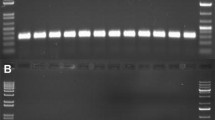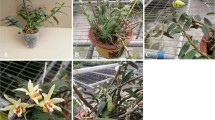Abstract
Deoxyribonucleic acid (DNA) fragment analysis can become an effective tool to study genetic differences between species and individuals on saccharinan kelp from which the little genetic diversity has been reported. Here, extraction methods of DNA suitable for use in analysis with a capillary sequencer is examined on Saccharina japonica var. diabolica which contains abundant polysaccharide. When amplified fragment length polymorphism was performed using genomic DNA extracted by seven different methods: (1) commercial kit, (2) original cetyl trimethylammonium bromide (CTAB) method, (3)–(5) three types of modified CTAB method, (6) modified sodium dodecyl sulfate (SDS) method, (7) combination of CTAB method and SDS method, a high reproducible peak that was suitable for analysis was noticeable in the electropherogram in the experiment with the last combination method (7). It is considered that the pretreatment washing of polysaccharide and the subsequent purification for protein and ribonucleic acid in SDS method and for polysaccharide in CTAB method are effective to obtain the high-purity DNA.




Similar content being viewed by others
References
Adams RP, Zhong M, Fei Y (1999) Preservation of DNA in plant specimens: inactivation and re-activation of DNases in field specimens. Mol Ecol 8:681–684
Barnwell P, Blanchard AN, Bryant JA, Smirnoff N, Weir AF (1998) Isolation of DNA from the highly mucilagenous succulent plant Sedum telphium. Plant Mol Biol Rep 16:133–138
Bartsch I, Wiencke C, Bischof K, Buchholz CM, Buck BH, Eggert A, Feuerpfeil P, Hanelt D, Jacobsen S, Karez R, Karsten U, Molis M, Roleda MY, Schubert H, Schumann R, Valentin K, Weinberger F, Wiese J (2008) The genus Laminaria sensu lato: recent insights and developments. Eur J Phycol 43:1–86
Bharmauria V, Verma V, Narang N, Sharma S (2010) Efficient DNA isolation from Emblica officinalis for effective PCR. Sci Res Essays 5:105–109
Biss P, Freeland J, Silvertown J, McConway K, Lutman P (2003) Successful amplification of rice chloroplast microsatellites from century-old grass samples from the park grass experiment. Plant Mol Biol Rep 21:249–257
Brunner I, Brodbeck S, Büchler U, Sperisen C (2001) Molecular identification of fine roots of trees from the Alps: reliable and fast DNA extraction and PCR-RFLP analyses of plastid DNA. Mol Ecol 10:2079–2087
Coyer JA, Hoarau G, Pearson G, Mota C, Jüterbock A, Alpermann T, John U, Olsen JL (2011) Genomic scans detect signatures of selection along a salinity gradient in populations of the intertidal seaweed Fucus serratus on a 12 km scale. Mar Genom 4:41–49
Crowley TM, Muralitharan MS, Stevenson TW (2003) Isolating conifer DNA: a superior polysaccharide elimination method. Plant Mol Biol Rep 21:97a–97d
Davis RW, Thomas M, Cameron J, John TPS, Scherer S, Padgett A (1980) Rapid DNA isolations for enzymatic and hybridization analysis. Meth Enzymol 65:404–411
Dellaporta SL, Wood J, Hicks JB (1983) A plant DNA minipreparation: version II. Plant Mol Biol Rep 1:19–21
Dempster EL, Pryor KV, Francis D, Young JE (1999) Rapid DNA extraction from ferns for PCR-based analyses. Biotechniques 27:66–68
Donaldson SL, Chopin T, Saunders GW (1998) Amplified fragment length polymorphism (AFLP) as a source of genetic markers for red algae. J Appl Phycol 10:365–370
Donaldson SL, Chopin T, Saunders GW (2000) An assessment of the AFLP method for investigating population structure in the red alga Chondrus crispus Stackhouse (Gigartinales, Florideophyceaae). J Appl Phycol 12:25–35
Drábková L, Kirschner J, Vlĉek Ĉ (2002) Comparison of seven DNA extraction and amplification protocols in historical herbarium specimens of Juncaceae. Plant Mol Biol Rep 20:161–175
Ghosh R, Paul S, Ghosh SK, Roy A (2009) An improved method of DNA isolation suitable for PCR-based detection of begomoviruses from jute and other mucilaginous plants. J Virol Methods 159:34–39
Goldenberger D, Perschil I, Ritzler M, Altwegg M (1995) A simple “universal” DNA extraction procedure using SDS and proteinase K is compatible with direct PCR amplification. Genome Res 4:368–370
Haque S, Ashraf N, Awal A, Sarker RH, Begum S, Khan H (2004) Method for quality DNA isolation from different parts of jute plant: Corchorus capsularis L. and C. olitorius L. Plant Tissue Cult 14:143–148
Jena RC, Samal KC, Das BK (2010) Optimization of DNA isolation and PCR protocol for RAPD analysis of Mangifera indica L. J Agric Technol 6:559–571
Kejani AA, Tafreshi SAH, Nekouei SMK, Mofid MR (2010) Efficient isolation of high quality nucleic acids from different tissues of Taxus baccata L. Mol Biol Rep 37:797–800
Khanuja SPS, Shasany AK, Darokar MP, Kumar S (1999) Rapid isolation from dry fresh samples of plants producing large amounts of secondary metabolites and essential oils. Plant Mol Biol Rep 17:1–7
Kitade Y, Yamazaki S, Saga N (1996) A method for extraction of high molecular weight DNA from the macroalga Porphyra yezoensis (Rhodophyta). J Phycol 32:496–498
Kusumo HT, Druehl LD (2000) Variability over space and time in the genetic structure of the winged kelp Alaria marginata. Mar Biol 136:397–409
Kusumo HT, Pfister CA, Wootond JT (2004) Dominant (AFLP) and co-dominant (microsatellite) markers for the kelp Postelsia palmaeformis (Laminariales). Mol Ecol Notes 4:372–375
Lobban CS, Harrison PJ (1994) Seaweed ecology and physiology. Cambridge University Press, Cambridge
Macaya EC, Zuccarello GC (2010) Genetic structure of the giant kelp Macrocystis pyrifera along the southeastern Pacific. Mar Ecol Prog Ser 420:103–112
Murray MG, Thompson WF (1980) Rapid isolation of high molecular weight plant DNA. Nucleic Acids Res 19:4321–4325
Niu C, Kebede H, Auld DL, Woodward BG, Wright RJ (2008) A safe inexpensive method to isolate high quality plant and fungal DNA in an open laboratory environment. Afr J Biotechnol 7:2818–2822
Niwa K, Kikuchi N, Iwabuchi M, Aruga Y (2004) Morphological and AFLP variation of Porphyra yezoensis Ueda form narawaensis Miura (Bangiales, Rhodophyta). Phycol Res 52:180–190
Phillips N, Smith CM, Morden CW (2001) An effective DNA extraction protocol for brown algae. Phycol Res 49:97–102
Porebski S, Bailey LG, Baum BR (1997) Modification of a CTAB DNA extraction protocol for plants containing high polysaccharide and polyphenol components. Plant Mol Biol Rep 15:8–15
Shan TF, Pang SJ (2009) Assessing genetic identity of sporophytic offspring of the brown alga Undaria pinnatifida derived from mono-crossing of gametophyte clones by use of amplified fragment length polymorphism and microsatellite markers. Phycol Res 57:36–44
Shan TF, Pang SJ, Zhang YR, Yakovleva IM, Skriptsova AV (2010) An AFLP-based survey of genetic diversity and relationships of major farmed cultivars and geographically isolated wild populations of Saccharina japonica (Phaeophyta) along the northwest coasts of the Pacific. J Appl Phycol 23:35–45
Shepherd M, Cross MJ, Stokoe RL, Scott LJ, Jones ME (2002) High-throughput DNA extraction from forest trees. Plant Mol Biol Rep 20:425–234
Shiroma R, Uechi S, Tawata S, Tako M (2007) Isolation and characterization of alginate from Hizikia fusifolmis and preparation of its oligosaccharides. J Appl Glycosci 54:85–90
Shivji MS, Rogers SO, Stanhope MJ (1992) Rapid isolation of high molecular weight DNA from marine macroalgae. Mar Ecol Prog Ser 84:197–203
Sodmergen K, Kawano S, Tano S, Kuroiwa T (1991) Degradation of chloroplast DNA in second leaves of rice (Oryza sativa) before leaf yellowing. Protoplasma 160:89–98
Wang D, Wang X, Li D, Wang F, Duan D (2006) The genetic analysis and germplasm identification of the gametophytes of Undaria pinnatifida (Phaeophyceae) with RAPD method. J Appl Phycol 18:801–809
Weising K, Nybom H, Wolff K, Kahl G (2005) DNA fingerprinting in plants: principles, methods, and applications, 2nd edn. CRC Press, Boca Raton, p 103
Yotsukura N (2005) Molecular phylogeny of advanced kelps (Laminariales, Phaeophyceae) growing in Japan. Nat Hist Res Spec Issue 8:69–81
Yotsukura N, Denboh T, Motomura T, Horiguchi T, Coleman AW, Ichimura T (1999) Little divergence in ribosomal DNA internal transcribed spacer-1 and -2 sequences among non-digitate species of Laminaria (Phaeophyceae) from Hokkaido, Japan. Phycol Res 47:71–80
Yotsukura N, Kawai T, Kawashima S, Ebata H, Ichimura T (2006) Nucleotide sequence diversity of the 5S rDNA spacer in the simple blade genera Laminaria, Cymathaere, and Kjellmaniella (Laminariales, Phaeophyceae) from northern Japan. Phycol Res 54:269–279
Yotsukura N, Kawashima S, Kawai T, Abe T, Druehl LD (2008) A systematic re-examination of four Laminaria species: L. japonica, L. religiosa, L. ochotensis and L. diabolica. J Jpn Bot 83:165–176
Yotsukura N, Shimizu T, Katayama T, Druehl LD (2010) Mitochondrial DNA sequence variation of four Saccharina species (Laminariales, Phaeophyceae) growing in Japan. J Appl Phycol 22:243–251
Acknowledgment
The authors thank Prof S. J. Pang and Dr T. F. Shan (Institute of Oceanology, Chinese Academy of Sciences) for kind advice and useful comments. The authors also thank Mr S. Hamano and Mr H. Katsuragawa (Hokkaido University) for collecting materials. This research was supported by a research project, grant-in-aid for Scientific Research (21241055) from the Ministry of Education, Science, Sports and Culture, Japan and by the Environment Research and Technology Development Fund (S9) by the Ministry of the Environment, Japan.
Author information
Authors and Affiliations
Corresponding author
Rights and permissions
About this article
Cite this article
Maeda, T., Kawai, T., Nakaoka, M. et al. Effective DNA extraction method for fragment analysis using capillary sequencer of the kelp, Saccharina . J Appl Phycol 25, 337–347 (2013). https://doi.org/10.1007/s10811-012-9868-3
Received:
Revised:
Accepted:
Published:
Issue Date:
DOI: https://doi.org/10.1007/s10811-012-9868-3




